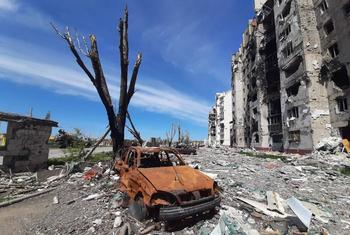
Mariupol City Council
The southern Ukrainian port city of Mariupol, devastated after months of Russian bombardment, it was eventually occupied by Russian forces.
December 09, 2022 Peace and Security
The only way to end the suffering and devastation in Ukraine, “is by ending the war”, the UN’s top disarmament official told the Security Council on Friday.
Briefing reportedly at the request of Russia on “supplies of lethal weapons to Ukraine and their consequences”, Izumi Nakamitsu reminded ambassadors that she had already addressed the issue in September.
Risk of diversion
The UN Disarmament Affairs (UNODA) chief repeated what she had said then, that a large-scale influx of weapons into any battle-zone, “raises many concerns for peace and security” which includes “risks of diversion as well as potential spillover and escalation.”
She said it was a matter of public record that States were transferring weapons systems and ammunition to Ukraine for use by its defence forces against Russian attacks.
Ms. Nakamitsu added that there had also been “widespread and independently verified reports of the transfer of major conventional weapons systems to non-State groups involved in the conflict against Ukraine, including artillery rocket systems.”
Arms control
She said what happens to weapons systems in the period after the guns fall silent, was also a major issue, crucial to any successful, lasting peace deal.
“Measures to counter the potential diversion of weapons and ammunition, will be key to post-conflict recovery and regional security and stability, as to conflict potential in other regions.”
Transparency and accountability
Equally important, she said, was the need to safeguard and account for all military equipment transferred. She pointed to the UN Register of Conventional Arms as a key tool, alongside the Arms Trade Treaty.
She said all Member States should follow these policy approaches and use the tools already available, for transparency’s sake, so that weapons don’t disappear onto the black market.
Civilian suffering
Beyond the facts and figures, she urged all combatants in Ukraine and everywhere else, to realize their duty to protect civilians from weapons of war.
Already, more than 17,000 Ukrainians had died or been injured, “with the numbers incessantly rising”, she said, most of them killed by explosive weapons.
Russia’s attacks on a wide range of civilian infrastructure, including the energy grid as the deadly cold winter sets in, brings “a new dimension to the humanitarian crisis, putting millions at risk.”
International humanitarian law is clear she said: “combatants must not direct attacks against civilians or civilian infrastructure and must take all feasible precautions in the conduct of military operations to avoid, or at least minimize, incidental loss of life, injury to civilians, and damage to civilian objects.”
Devastation in towns and cities
Citing last month’s adoption of the Political Declaration on Strengthening the Protection of Civilians from the Humanitarian Consequences Arising from the Use of Explosive Weapons in Populated Areas, signed by over 80 States, the UNODA chief said it was a “milestone in our efforts to better protect civilians”, calling on all countries to join.
“The past nine months have seen tremendous devastation – much as a result of the use of heavy conventional weapons. Attacks against civilians and civilian infrastructure must stop.”
Stop the diversion of arms
Finally, she called on States to apply effective arms control measures to address risks related to arms disappearing, only to resurface elsewhere.
Preventing the diversion to other battlefields is essential, she stressed, “to avoid fuelling conflict and insecurity in the region and beyond.”
